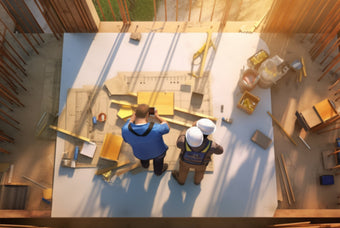Most popular
Are you a commercial property owner looking to maximize occupancy rates and increase returns on investment? The answer might lie in adaptive reuse. By reimagining and repurposing existing commercial properties, you can unlock their hidden potential and revitalize them for new opportunities. Adaptive reuse is the practice of transforming old or underutilized buildings into vibrant spaces that meet the needs of today's businesses and consumers. Whether it's converting an old warehouse into trendy loft apartments or turning an abandoned factory into a lively retail center, adaptive reuse offers countless possibilities.
Not only does adaptive reuse breathe new life into neglected properties, but it also brings multiple benefits. It helps preserve historical and architectural elements, reduces environmental impact, and often costs less than new construction. Additionally, adaptive reuse projects can help attract a new demographic of tenants and customers, adding value to the surrounding community. In this article, we will explore the various advantages of adaptive reuse, share inspiring examples of successful projects, and provide practical tips for implementing adaptive reuse strategies in your commercial properties. Unlock the untapped potential of your buildings and discover how adaptive reuse can transform them into thriving and profitable spaces.
Understanding Adaptive Reuse in Commercial Properties
Adaptive reuse refers to the process of repurposing existing commercial properties for new uses. This approach involves taking a creative and innovative approach to transform buildings that may no longer serve their original purpose into spaces that align with current market demands. The concept of adaptive reuse has gained popularity in recent years as property owners and developers recognize the potential in revitalizing existing structures rather than starting from scratch.

The beauty of adaptive reuse lies in its ability to breathe new life into old spaces, preserving their historical and architectural significance while adapting them to meet modern needs. By repurposing existing buildings, property owners can avoid the high costs and environmental impact associated with demolition and new construction. Instead, they can leverage the unique characteristics of the property to create a one-of-a-kind space that stands out in the market.
Moreover, adaptive reuse projects contribute to the preservation of cultural heritage and the character of communities. By repurposing historical buildings, property owners can retain the charm and uniqueness of the structure while giving it a new purpose. This not only adds value to the building itself but also enhances the surrounding neighborhood, attracting visitors, tenants, and customers who appreciate the blend of history and modernity.
In summary, adaptive reuse presents a sustainable and economically viable solution for commercial property owners looking to unlock the untapped potential of their buildings. By repurposing existing structures, property owners can preserve history, reduce environmental impact, and create unique spaces that attract a diverse range of tenants and customers.
Benefits of Adaptive Reuse for Commercial Properties
- Cost-Effectiveness: One of the most significant advantages of adaptive reuse is its cost-effectiveness compared to new construction. Repurposing an existing building typically involves lower construction and material costs, as the basic structure is already in place. Additionally, adaptive reuse projects may be eligible for tax incentives and grants, further reducing the financial burden.
- Preservation of Historical and Architectural Elements: Adaptive reuse allows property owners to preserve the historical and architectural elements of a building, adding value and uniqueness to the space. Retaining these elements not only contributes to the cultural heritage of the community but also creates a visually appealing environment that attracts tenants and customers.
- Reduced Environmental Impact: By repurposing existing buildings, adaptive reuse projects help reduce the environmental impact associated with new construction. The reuse of materials, as well as the preservation of existing structures, reduces the demand for new resources and minimizes waste. This sustainable approach aligns with the growing emphasis on green building practices and can enhance the reputation of the property owner.
- Attracting New Demographics: Repurposing a commercial property through adaptive reuse opens up opportunities to attract new demographics of tenants and customers. For example, transforming an old warehouse into trendy loft apartments can appeal to young professionals seeking unique living spaces. Similarly, converting an abandoned factory into a vibrant retail center can attract a diverse mix of businesses and customers. By adapting to current market demands, property owners can tap into new markets and increase the attractiveness of their spaces.
- Community Enhancement: Adaptive reuse projects have the potential to enhance the surrounding community by creating vibrant spaces that contribute to the local economy and culture. Repurposing neglected buildings can revitalize neighborhoods, attract additional investment, and generate employment opportunities. The adaptive reuse of commercial properties often leads to increased foot traffic, which can benefit nearby businesses and improve the overall livability of the area.
With these benefits in mind, commercial property owners can see the potential of adaptive reuse in unlocking higher occupancy rates, increasing returns on investment, and contributing to the overall sustainability and vibrancy of the community.
Case Studies of Successful Adaptive Reuse Projects
-
The High Line, New York City: The High Line, a 1.45-mile-long elevated park in Manhattan, is an iconic example of successful adaptive reuse. It was once an abandoned elevated railway track that had fallen into disrepair. Instead of demolishing the structure, it was transformed into a unique public park that attracts millions of visitors each year. The project not only preserved the historical railway structure but also revitalized the surrounding neighborhood, leading to increased property values and economic development.
-
The Battery, San Francisco: The Battery is a private members' club located in a historic building in San Francisco's Financial District. The building, originally constructed in 1907, served as a factory and warehouse before being repurposed into a luxurious social club. The adaptive reuse project retained the building's original architectural elements while adding modern amenities, creating a truly unique and exclusive space. The Battery's success demonstrates the potential for adaptive reuse in creating high-end, niche experiences that cater to specific target markets.
-
The Loom, London: The Loom, a coworking space in London, is a prime example of adaptive reuse in the commercial real estate sector. The building was formerly a Victorian wool warehouse and was transformed into a vibrant coworking space that caters to a diverse community of entrepreneurs, freelancers, and small businesses. The adaptive reuse project retained the industrial charm of the building while providing modern amenities and flexible workspace solutions. The Loom's success highlights the potential for adaptive reuse in meeting the evolving needs of the modern workforce.
These case studies illustrate the diverse range of possibilities that adaptive reuse offers for commercial property owners. By repurposing existing buildings, property owners can create unique and highly desirable spaces that stand out in the market, attract new tenants, and generate higher returns on investment.

Factors to Consider When Planning for Adaptive Reuse
- Property Condition and Suitability: Before embarking on an adaptive reuse project, it is crucial to assess the condition and suitability of the property. Consider factors such as structural integrity, zoning regulations, and accessibility. Engage professionals such as architects and engineers to conduct thorough inspections and feasibility studies to ensure the property is suitable for the desired reuse.
- Market Analysis: Conduct a comprehensive market analysis to identify the current demand and trends in the area. Understanding the target market and potential tenant/customer preferences will help determine the most suitable adaptive reuse strategy. Consider factors such as demographics, competition, and market saturation to ensure the project aligns with market demands.
- Historical and Architectural Significance: If the property has historical or architectural significance, it is important to engage with local heritage and planning authorities. They can provide guidance on preserving and incorporating these elements into the adaptive reuse project while ensuring compliance with regulations.
- Financial Feasibility: Assess the financial feasibility of the adaptive reuse project by conducting a thorough cost-benefit analysis. Consider factors such as construction costs, potential rental income, operating expenses, and financing options. Engage with financial advisors and real estate professionals to accurately evaluate the financial viability of the project.
- Permitting and Code Compliance: Ensure compliance with local building codes, permits, and regulations throughout the adaptive reuse process. Engage with local authorities and consult professionals to navigate the complex permitting and compliance requirements.
By considering these factors during the planning phase, commercial property owners can lay a solid foundation for a successful adaptive reuse project.
Steps in the Adaptive Reuse Process
-
Concept Development: Develop a clear vision and concept for the adaptive reuse project. Determine the desired use, target market, and unique selling points of the space. Engage with architects, designers, and other professionals to brainstorm ideas and create a compelling concept.
-
Feasibility Study: Conduct a comprehensive feasibility study to assess the viability of the adaptive reuse project. Evaluate factors such as market demand, financial feasibility, and regulatory requirements. Engage with professionals to analyze the potential risks and benefits associated with the project.
-
Design and Planning: Collaborate with architects and designers to develop detailed plans for the adaptive reuse project. Consider factors such as space utilization, functionality, and preservation of historical and architectural elements. Ensure compliance with building codes and regulations.
-
Permitting and Approvals: Obtain the necessary permits and approvals from local authorities. This may include zoning permits, construction permits, and approvals from heritage and planning authorities. Engage with professionals to navigate the permitting process efficiently.
-
Construction and Renovation: Execute the construction and renovation phase of the adaptive reuse project. Engage with contractors, suppliers, and other professionals to ensure high-quality workmanship and timely completion. Monitor the progress closely to ensure adherence to the design plans and budget.
-
Marketing and Leasing: Develop a comprehensive marketing strategy to attract tenants and customers to the newly repurposed space. Highlight the unique features and benefits of the adaptive reuse project to differentiate it from competitors. Engage with real estate professionals and marketing experts to maximize exposure and attract the target market.
-
Ongoing Management and Maintenance: Once the adaptive reuse project is complete and tenants/customers occupy the space, ensure ongoing management and maintenance. Regularly assess the performance of the space, address maintenance issues promptly, and adapt to changing market demands. Engage with property management professionals to ensure the smooth operation of the repurposed space.
By following these steps, commercial property owners can navigate the adaptive reuse process successfully and maximize the potential of their buildings.
Common Challenges in Adaptive Reuse Projects and How to Overcome Them
-
Structural Limitations: Older buildings often have structural limitations that need to be addressed during the adaptive reuse process. Engage with structural engineers to assess the integrity of the building and develop solutions to overcome these limitations.
-
Code Compliance: Adapting an existing building to meet current building codes and regulations can be challenging. Consult with architects, engineers, and local authorities to ensure compliance with all applicable codes and regulations.
-
Financing and Funding: Securing financing for adaptive reuse projects can be challenging, especially for property owners without a strong financial background. Engage with financial advisors and explore funding options such as grants, tax incentives, and loans catered specifically to adaptive reuse projects.
-
Community Opposition: Some adaptive reuse projects may face opposition from community members who are resistant to change or have concerns about the impact on the neighborhood. Engage with the community early on, address their concerns, and communicate the benefits of the adaptive reuse project to gain their support.
-
Unforeseen Conditions: During the construction and renovation phase, unforeseen conditions may arise, leading to delays and additional costs. It is important to have contingency plans in place and engage with professionals who can effectively manage unforeseen challenges.
By proactively addressing these challenges and engaging with professionals who specialize in adaptive reuse projects, commercial property owners can overcome obstacles and ensure the success of their revitalization efforts.
Financial Considerations for Adaptive Reuse Projects
-
Budgeting and Cost Estimation: Develop a detailed budget for the adaptive reuse project, taking into consideration construction costs, design fees, permit fees, and other expenses. Engage with professionals to accurately estimate costs and avoid budget overruns.
-
Financing Options: Explore different financing options for adaptive reuse projects. This may include traditional commercial real estate loans, government grants and incentives, historic tax credits, and crowdfunding. Engage with financial advisors and lenders who specialize in adaptive reuse projects to identify the most suitable financing options.
-
Return on Investment Analysis: Conduct a return on investment (ROI) analysis to assess the financial viability of the adaptive reuse project. Consider factors such as potential rental income, operating expenses, and the anticipated increase in property value. Engage with real estate professionals to accurately evaluate the ROI and make informed investment decisions.
-
Tax Implications: Understand the tax implications of the adaptive reuse project, including potential tax incentives and benefits. Engage with tax professionals to ensure compliance with tax regulations and maximize available tax advantages.
By carefully considering the financial aspects of adaptive reuse projects and engaging with professionals who specialize in commercial real estate financing, property owners can make informed financial decisions and maximize the returns on their investments.
Best Practices for Marketing and Leasing Adaptive Reuse Properties
-
Highlight Unique Features: Emphasize the unique features and benefits of the adaptive reuse property in marketing materials and leasing efforts. Showcase the historical or architectural elements, the sustainability aspects, and the character of the space. Differentiate the property from competitors by highlighting its distinctive qualities.
-
Targeted Marketing: Develop a targeted marketing strategy to reach the desired tenant/customer demographic. Utilize online platforms, social media, and local advertising to promote the adaptive reuse property to the target market. Engage with marketing professionals who specialize in commercial real estate to maximize exposure and attract the right audience.
-
Collaborate with Local Businesses: Partner with local businesses and organizations to create a sense of community and enhance the appeal of the adaptive reuse property. This can include hosting joint events, offering discounts to nearby businesses, or collaborating on marketing initiatives. By fostering a sense of community, the adaptive reuse property can become a destination that attracts tenants and customers.
-
Flexible Leasing Options: Consider offering flexible leasing options to attract a diverse range of tenants. This may include short-term leases, shared spaces, or customizable layouts. By catering to the evolving needs of businesses, the adaptive reuse property can attract a wider pool of potential tenants.
-
Engage with Real Estate Professionals: Partner with real estate professionals who specialize in adaptive reuse properties. They can provide valuable insights into the market, assist with leasing efforts, and help position the property effectively. Their expertise and network can be instrumental in maximizing occupancy rates and achieving higher returns on investment.
By implementing these best practices, commercial property owners can effectively market and lease their adaptive reuse properties, attracting the right
Empty content. Please select category to preview
Join our newsletter now
Promotions, new products and sales. Directly to your inbox.





